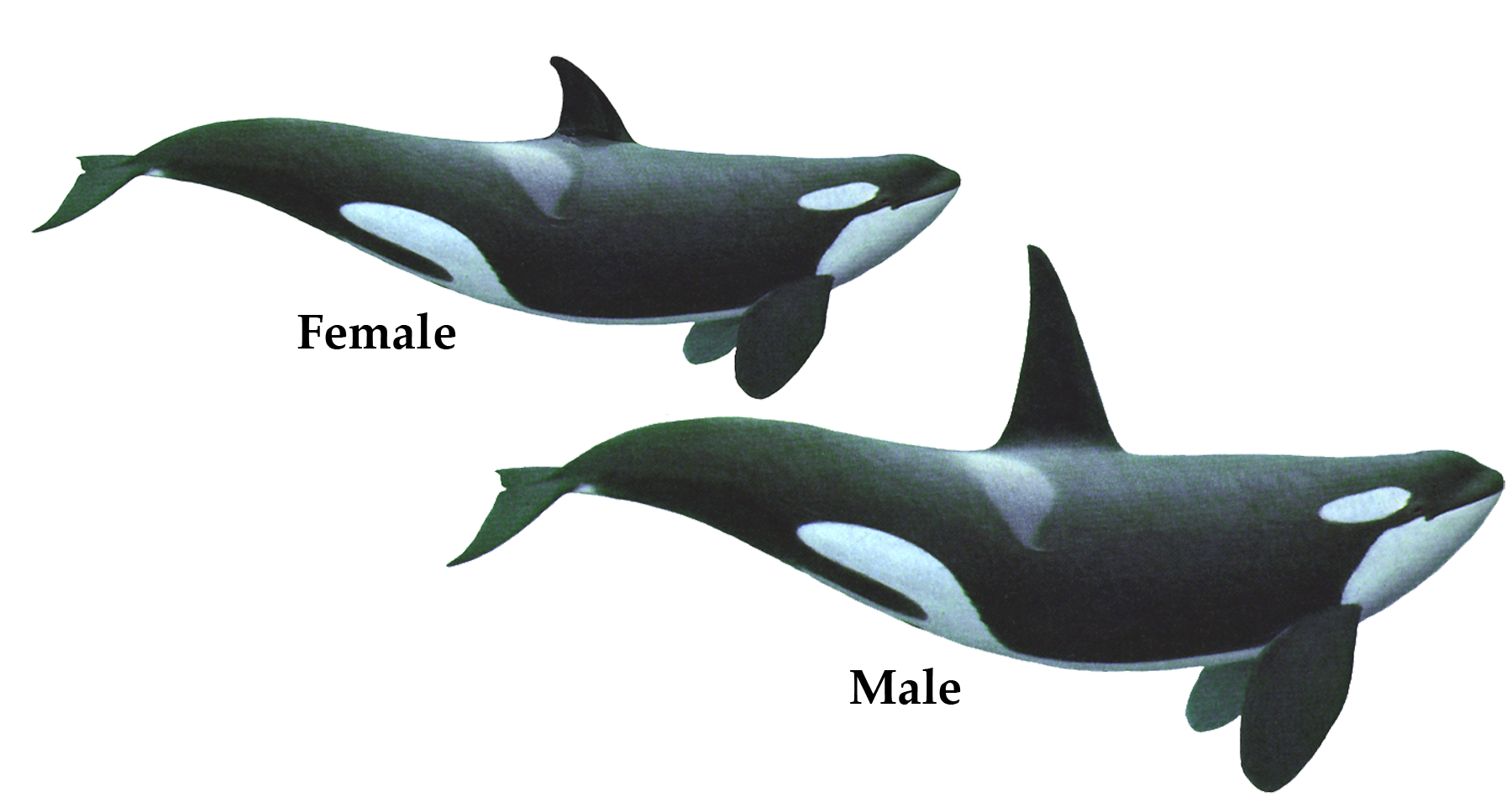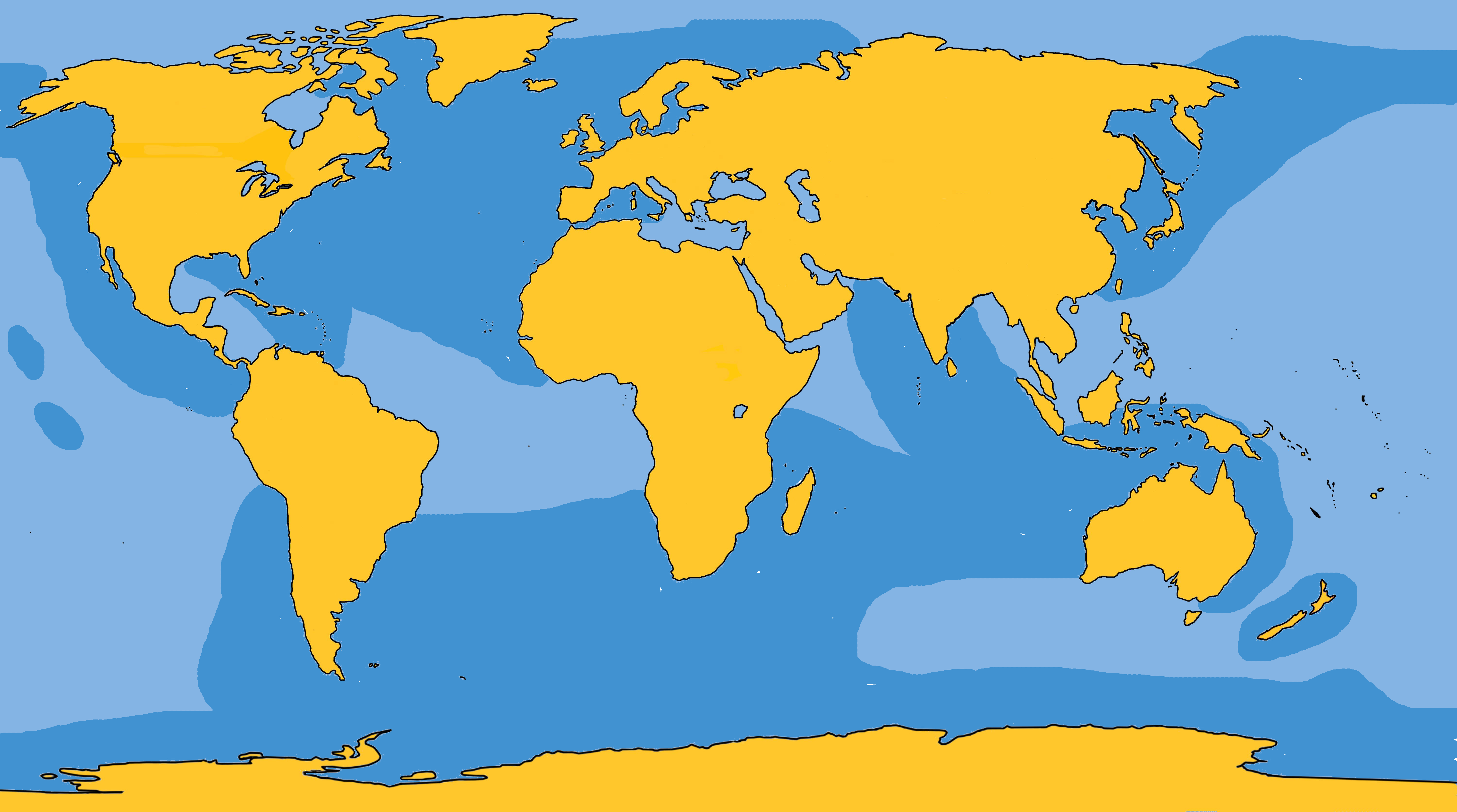Orca
Family: Delphinidae
Genus: Orcinus
Species: O. orca (Linnaeus, 1758)
The killer whale, often called “Orca” from its Latin name, is in reality a dolphin, and by far the largest member of that group. Killer whales hunt in packs, and although the bulk of their diet consists of fish and cephalopods such as squid, some populations also hunt and eat seals, sea lions, penguins, dolphins, porpoises, and have been observed attacking and eating the larger whales, including the blue whale. In the wild there is no record of killer whales attacking humans, even though people (mostly researchers) swim with wild herds all over the world. They have a remarkably wide distribution, inhabiting all waters of the world, from polar seas to tropical waters, although they seem most numerous in the Atlantic and Pacific oceans. The name “killer whale” seems to have originated from early Spanish whalers, who called them “whale killers”, for, as mentioned, some populations do hunt the great whales. The Spanish-to-English translation shifted the adjective from the rear to the front; hence, the name “killer whales”.
The killer whale’s pigmentation is striking and varies greatly among geographic populations. Males of the Antarctic, for example, have a much larger eye patch than those of other populations.
The killer whale’s social structure is highly evolved. Long-term observations have confirmed regularity in certain habits and feeding patterns. Family units remain intact over long periods, and the underwater vocalizations of killer whales strongly suggest that the animals are always in communication with one another. Killer whales societies are matriarchal; the males stay with their mother for their entire life.
It is interesting that this animal, which for so long was considered a rapacious marauder of the deep, is in reality capable of gentle, responsive, and sensitive behavior.
Physical Description: When observed at close range, this long, thick, and very streamlined animal cannot be mistaken for anything else. The head is bluntly tapered with definite indentations forming the rounded upper lip. The blowhole is located slightly to the left on the forehead. Males are bulkier than females, especially the head and flippers.
There is a wide variety of orcas that many are now suggesting as sub-species and in one case (the “Type D” orca) a possible new species. For more information on this, play the video below.
Color: Jet black with clearly delineated snow-white regions—white on the underside from the entire lower jaw to the beginning of the flippers, narrowing along the ventral ridge to just past the anus. From just before the anus, the white rises as separate patches on both sides curving toward the tail, ending on the dorsal side at about the same point as on the ventral ridge; white in dark regions on each side of the head beginning above the eye and extending back to about the beginning of the flippers. Many individuals have a lighter color pattern just behind the dorsal fin extending asymmetrically to dissolve in the dark anterior regions. The white areas are yellow-pink in newborns. The white patch above and to the rear of each eye can vary in shape and size with each geographic population.
Fins and Flukes: In males, the dorsal fin can grow to 6 ft. (1.8m) in height; in females, it ceases at 3 ft. (91 cm). Flippers are noticeably wider and larger in males than in females. Broad flukes are extremely well developed, with a definite median notch.
Length and Weight: Males are known to reach 32 ft. (10 m) and 11 tons (10,000 kg). Females are considerably smaller, reaching 28 ft. (8.5 m) and 8.25 tons (7,700 kg).
Teeth: 10 to 12 large conical teeth are found on each side of the upper and lower jaws. Teeth are slightly curved back and inward.
Feeding: Their diet is often geographic or population-specific and can include fish, marine mammals, sharks, and sea birds.
Breathing and Diving: Killer whales breathe usually every 10 to 30 seconds for a series of a dozen or so short dives, followed by a dive than can last up to 4 minutes.
Mating and Breeding: Breeding season is thought to last all year. Calves, about 8 ft. (2.4 m), weighing 400 lb. (182 kg), are born after a 15 to 18-month gestation period. Males reach sexual maturity at about 22 ft. (6.7 m); females at about 15-18 ft. (4.6-5.4 m). Calves are nursed for about a year and are weaned at 1 to 2 years of age. Calves are usually dependent on their mothers for the first year.
Herding: Often between 2 to 8. In the Pacific Northwest, separate and distinct pods often come together to form what researchers call “super pods”.
Distribution: All oceans; coastal waters and cooler regions preferred. There are distinct populations of killer whales identified by subtle differences in the shape of the dorsal fin and coloration.
Migration: Some herds appear to move toward the equator during winter and toward polar regions during summer, but definitive migratory patterns, if any, are not known. Some herds are residents of specific regions all year long.
Natural History Notes: Killer whales are very active animals on the surface, often leaping clear of the water. They are very inquisitive, and often approach small boats at close range.
KILLER WHALE DISTRIBUTION








